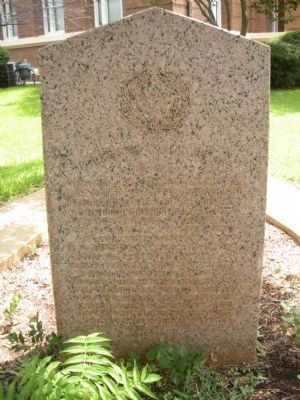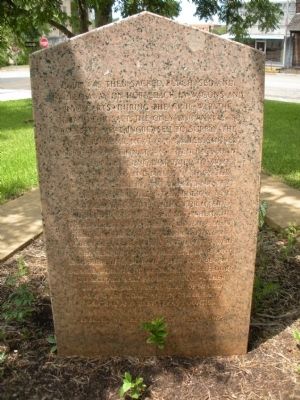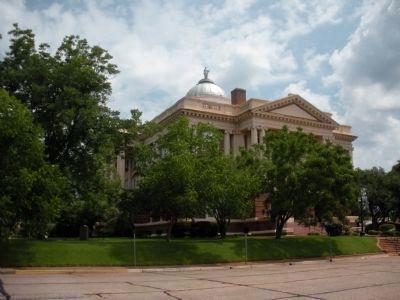Palestine in Anderson County, Texas — The American South (West South Central)
Palestine Salt Works C.S.A.
Located 6.5 miles southwest during the Civil War this salt works was assigned to produce salt for the Confederacy at a fixed price of eight dollars for a hundred-pound sack. Private customers from East Texas, Arkansas, and Louisiana often paid twenty dollars for a sack. Producing salt was slow, tedious work. Salt water was taken from wells spread over a distance of three-fourths of a mile. A pump operated by a slave was placed in each well. Gum logs hollowed out and joined together, formed a pipeline from the wells to large cast iron boiling kettles which were kept fired. Heated water was then transferred to smaller kettles for quick evaporation.
(Back and northeast side):
Salt was then sacked, purchased and hauled away on horseback, in wagons and in oxcarts. During the Civil War the demand for salt, the only known way to preserve meat, increased to supply the southern army. Meat was salted, smoked for preservation. It was then packed in salt for the long, hot trips to army camps. Horses and mules used by the cavalry, artillery, and quartermaster units required the vital mineral too. Salt also preserved hides for making shoes, harness and saddles. When the confederate government levied a meat tithe on farmers, the demand for salt increased. Often cattle and cotton were exchanged for salt which itself became a medium of exchange when salt became scarce, women dug up smokehouse floors to extract salt from the soil. Other Civil War salt works were operated along the coast and in other East, Central and West Texas counties.
Erected 1965 by The State of Texas. (Marker Number 8792.)
Topics. This historical marker is listed in this topic list: War, US Civil.
Location. 31° 45.879′ N, 95° 37.587′ W. Marker is in Palestine, Texas, in Anderson County. Marker is at the intersection of North Church Street (State Highway 19) and East Crawford Street, on the right when traveling north on North Church Street. Located on the lawn at the Anderson County Courthouse. Touch for map. Marker is at or near this postal address: 500 North Church Street, Palestine TX 75801, United States of America. Touch for directions.
Other nearby markers. At least 8 other markers are within walking distance of this marker. Anderson County Courthouse (within shouting distance of this marker); Governor Thomas Mitchell Campbell (within shouting distance of this marker); Micham Main (within shouting distance of this marker); Purvey Lee (P. L.) Chism (within shouting distance of this marker); Timothy Stephen Smith (within shouting distance of this marker); Palestine Fire Department (about 500 feet away, measured in a direct line); Anderson County (about 600 feet away); Col. Homer Garrison, Jr. (about 700 feet away). Touch for a list and map of all markers in Palestine.
Credits. This page was last revised on January 24, 2019. It was originally submitted on June 14, 2010, by Charles Marc Robinson of Palestine, Texas. This page has been viewed 3,160 times since then and 34 times this year. Photos: 1, 2, 3. submitted on June 14, 2010, by Charles Marc Robinson of Palestine, Texas. • Craig Swain was the editor who published this page.


